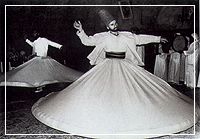
 |
|
| Welcome to Turizm.net! |
CAPPADOCIA / WHIRLING DERVISHES
 Islamic
mysticism seeks awareness of god in manner being, and hence the various
mystic sects o tarikats of dervishes or sufis have generally been
characterized by open-mindedness, vision, exuberance and lot of the arts,
particularly music and poetry. Their tendency to relegate doctrine and the
outer forms of worship a secondary degree of importance has frequently
brought the sects into conflict with orthodoxy over the centuries The
emphasis on dance music of the Mevlevis, and the transgression of the
orthodox ban on intoxicating liquor by the Bektaşis are issues which were
strongly condemned by the Muslim establishment during Ottoman times in
Turkey. Islamic
mysticism seeks awareness of god in manner being, and hence the various
mystic sects o tarikats of dervishes or sufis have generally been
characterized by open-mindedness, vision, exuberance and lot of the arts,
particularly music and poetry. Their tendency to relegate doctrine and the
outer forms of worship a secondary degree of importance has frequently
brought the sects into conflict with orthodoxy over the centuries The
emphasis on dance music of the Mevlevis, and the transgression of the
orthodox ban on intoxicating liquor by the Bektaşis are issues which were
strongly condemned by the Muslim establishment during Ottoman times in
Turkey.
The first Islamic sect emerged in Yemen and dates from the 37th year of the Hegira (657 AD) when the Angel Gabriel is supposed to have exhorted Üveys el-Karani to turn his back on the material world and choose a life of asceticism. Each mystic sect by tradition also asserts legitimacy by tracing its origins to Ali or Ebubekir Cüneyd-I Bagdadi (died 910) and other sufis forged a link between the concept of bezm-i elest (the union of God and souls) and the ecstatic dance known as sema introducing various recited litanies in praise of God to the accompaniment of whirling movements. Experts in Muslim jurisprudence have frequently rejected sects such as the Rufais, Halvetis and Mevlevis on the grounds that dancing degrades religion. In the early 16 th century , for instance, Ibn Kemal (d. 1534) wrote a treatise entitled "Risaletün fi Tahkik'r-Raks" asserting that music and spinning movements know as devran were sinful, citing early fetva as evidence for his argument, Ebussuud efendi (d.1574), on the other hand, while still disapproving, took the view that with certain modifications and restrictions the practice should be tolerated.
The sema of the Mevlevis differed from the movement adopted by other sects. The dervishes turned independently, without touching shoulder to shoulder, both around their own axis and around the sheikh and other dervishes. They made neither a sound no any movement of the hands arms or head The Mevlevi novice underwent long years of self-denial, penance and training in the sema The state of trans which the sema induced cut off all awareness apart from that of communion with God. The Bektaşis, however ridiculed the Mevlevi dance as an unnecessary adjunct to the worship of God. Mevlana(d. 1273) believed that the spirit was relieved of the weight of the flesh in the course of the sema, and that the jubilation which emanated from man2s true being as sense and thought could only be experienced in this way. Although the sema could be practiced singly, it was customary for the dervishes to perform the sema together at noon in the semahane or hall of dergah. The dervish responsible for the ritual would spread the sheepskin which symbol ised the office of the sheikh, head of the convent, on the floor of the semahane. Wearing their white costumes with voluminous skirts known as tennure and tall hats, the dervishes would perform their prayers when the sheikh warning a green headdress appeared. After readings from the Mesnevi and the Koran, one of the dervishes would begin to play the ney, a reed flute of great antiquity whose plaintive music is associated almost exclusively to the Mevlevi sect. Lord Charlemont, who traveled in Turkey in 1749 gave the following account of the Mevlevi ceremony, which was performed in public on Tuesdays and Fridays to an audience which included many women.
The Mevlevi dervishes had lodges in many parts of Turkey, including Afyon, Kütahya, Bursa, Gelibolu, Aleppo, and of course Konya the home of Mevlana. In İstanbul there were Mevlevi lodges at Kulekapısı, Bahariye in Beşiktaş, Kasımpaşa and Üsküdar. They all consisted of a large inner courtyard surrounded by the semahane, a room for the novices, reception rooms, a harem where the family of the sheikh lived, refectory, and kitchen. Day began with morning prayers and meditation, and continued with study of Mevlana's writings, and then music practice on the ney and kudüm, a small double drum played with small sticks. Although Charlemont referred to the dervishes as monks, the resemblance is only slight, since dervishes married, kept their own homes, and made their own livings. |
|
|
Home |
Turkey I
Cities & Sites
I Hotels I
Blue Cruise
I Tours I
Contact Us |
Search I
Ask for a quote to compare:
Cruises I
Biblical Tours I
Incentive Travel I
Hotels I
Transfers
Copyright © 1995-2016 Turizm.net
All rights reserved.